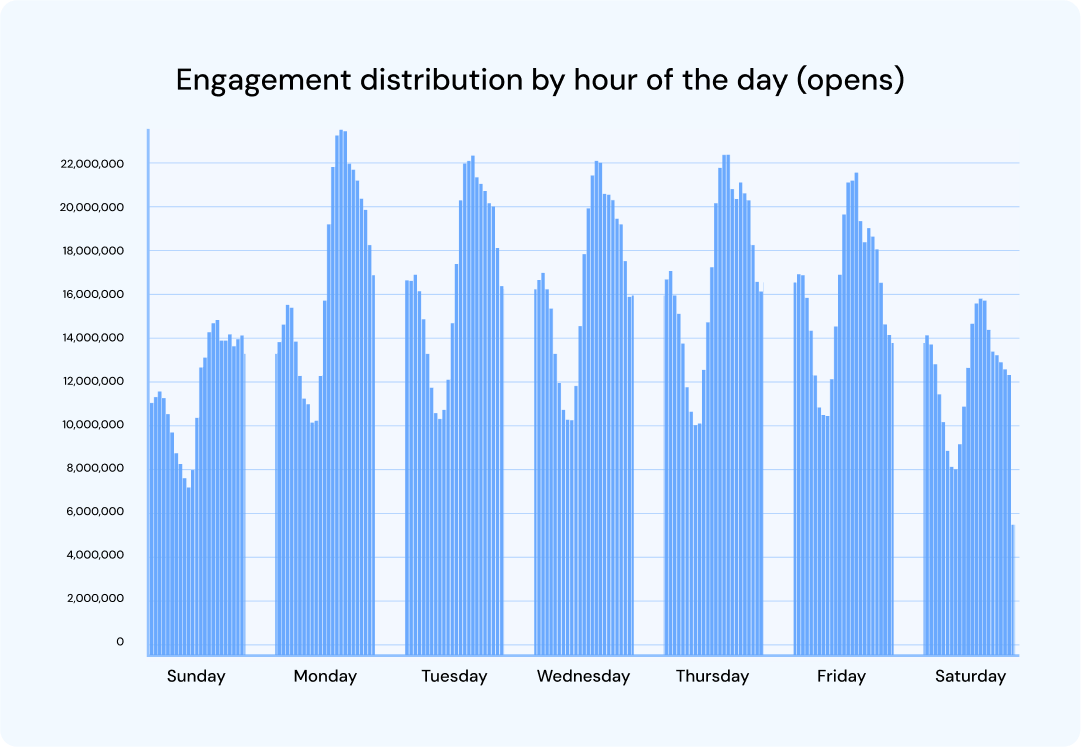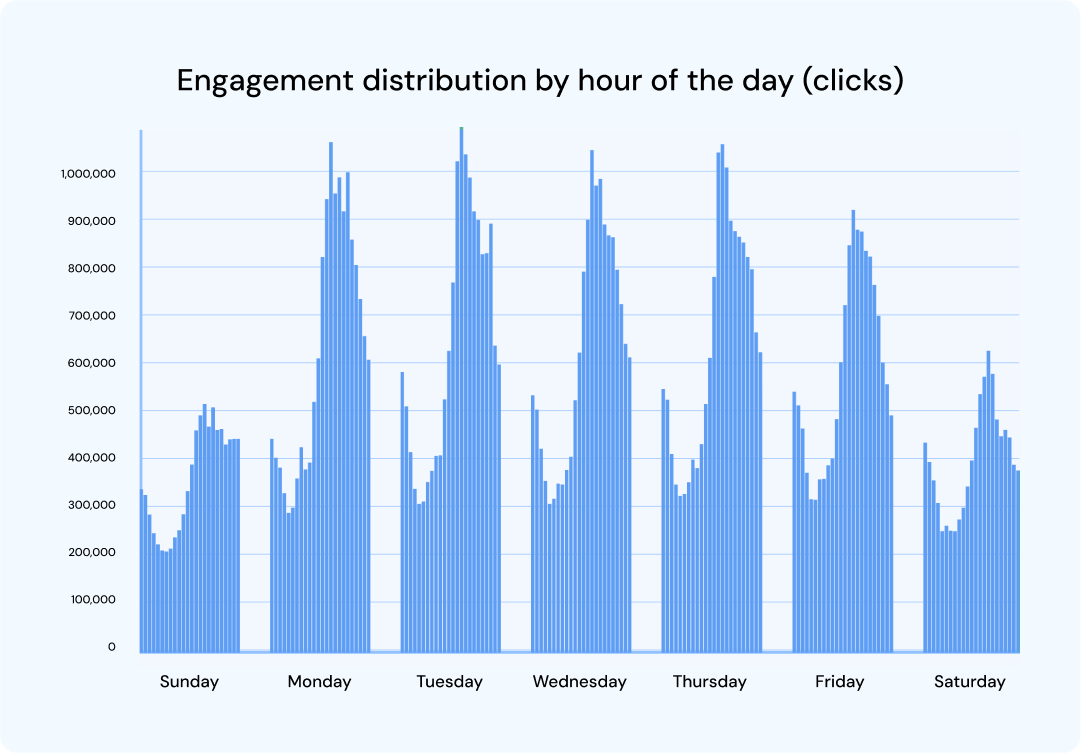The best time to send emails
When is the best time to send your emails to ensure they get read? Find out how to crack the email-sending code. Read more...
PUBLISHED ON
This is an updated version of the post The Best Time To Send Emails: Cracking The Code Header published by Mary Dolan on the Mailgun blog in September of 2022.
When it comes to code-breaking, the movies often make it look easy. A couple of rapid keyboard clicks, a quickly-guessed password or Indiana Jones-style riddle, and you’re in. When it comes to the best time to send email, however, cracking the code isn’t always that simple.
But have no fear, because we’re here to help you figure out the best send times for your email campaigns. First, let’s start with the code-breaking basics.
Table of contents
Before you find the perfect time, you need the right tools
After getting your tools, you need to know where you’re going
Finding the best time to send emails
Figuring out when to send your emails may seem like a one-step process, but there’s a lot of thought and research that should be done before you hit that “schedule” button. Check out some of the items below that you should check off your email-sending list.
Before you find the perfect time, you need the right tools
Let’s be honest – the details of sending email marketing campaigns should always be the last thing on your email list. Before you start worrying about the best time and best day of the week, you need to make sure that your emails are the best they can be. This means including important elements like:
An authenticated domain
A good sending reputation
An attention-getting subject line
Useful, well-written content
Engaged email subscribers
Unsubscribe links
Relevant images and calls-to-action
You may think that these elements are obvious, but even having one or two be subpar can seriously harm your open rates and click-through rates. So, pay attention to these parts of your email campaigns.
You should already know if you have an authenticated domain and a good sending reputation but, if you don’t have one or either, spend some time improving them. While these are the less flashy “backend” points of email marketing strategy, they have a huge impact on whether or not your emails are even delivered, much less obtain good metrics.
Also important, of course, is the content of your email. Give your subscribers content they want—an email subject line that speaks to their desires, content that grabs their attention, and relevant images and calls-to-action that illustrate your ideas and guide them toward further action.
Lastly, make sure your email subscribers are engaged with your email campaigns. If your subscribers aren’t engaged, no optimized time of day or day of the week is going to get them to change their minds. Make unsubscribe links easily accessible – that way, uninterested readers can easily leave your email list, and you can focus on the subscribers who want your content.
After getting your tools, you need to know where you’re going
Know where you’re going with your emails. By that, we basically mean: What are your email goals? In order to achieve success, you need to have a clear vision of what these goals are, and then plot your path toward them.
In every case, meeting your goals means knowing your audience. What do your audiences want? To know them better and cater to their needs, you can use tools like personalization, segmentation, and more. As with the above tips, knowing your audience may seem simple, but it plays a big part in cracking the code to the best time to send an email.
The best days to send an email
With your tools utilized and your emails optimized, it’s time to pick the perfect time to send them. So, what is that perfect timing? As you can see from the data below, the days of the week vary greatly when it comes to email engagement. Midweek weekdays, generally Tuesday through Thursday, have the highest email open rates.

Additionally, when it comes to email clicks, the same middle of the week period has the highest click-through rate. Sundays are the worst days, followed by Saturday and everyone’s favorite day, Monday.

The reasons for this trend aren’t that shocking. People are going to be checking their emails far more frequently – and actively – during the workweek than they are on the weekend. Additionally, during work hours, most people are going to be more engaged during midweek days than they are on Fridays (pre-weekend!) or Mondays (shaking off the last of the weekend).
So, when it comes to your promotional emails, trust what the data shows and stick to the middle workdays of the week. But, wait a minute, what about the best time of day to send an email? How do you know that you’re not sending at the very worst time? Well, luckily for you, we have more data to share with you. Onto the next heading…
Open rates remain one of the most important email metrics for monitoring performance, engagement, and even deliverability. But how do you get subscribers to open your messages? The answers of our customer experience survey may surprise you.
The best times to send an email
Finding the right time to send an email is important, but the key word here is time. Nowadays, any significant digital audience is almost always a global audience. This audience is going to have different habits, different routines and, most importantly, live in different time zones.
So, how do these differences affect your optimal sending times? Surely the best time in Paris is going to be the worst time in New York, right? Well, we can happily settle the argument about right times versus wrong times by framing all sending times in Coordinated Universal Time (UTC).
As you can see in the graphs above, audience engagement by day falls in line with our previous data. However, there are high fluctuations when it comes to exactly what hours of the day target audiences are engaging with messages and giving you those sweet, sweet high open rates and click-through rates.
15:00 UTC is marketers’ magic number when it comes to sending times, and that goes for any day of the week. You can easily convert UTC to your own time zone via a quick Google search (for example, 15:00 UTC translates to 11:00 AM for American Central Standard Time). After that, you can quickly use your best email time zones to obtain your highest open and click-through rates.
Also, a quick note: always avoid late hours when it comes to sending email. This includes email newsletters, business emails, and anything else that you really want to get read (which we assume is pretty much everything). Messages sent during late hours will get lost in the early morning inbox shuffle, and that’s bad news for your email campaigns.
Figure out your own best time to send email
Of course, emailing is rarely one-size-fits-all, and that goes for email sending times as well. While our advice is a good rule of thumb, you may discover that your mailing list subscribers have different habits and needs… including different sending times. Pay attention to your subscribers’ locations and habits to ensure that you’re sending them emails when the messages benefit them most.
Additionally, if you’re looking for a really great resource to help you solve the sending time puzzle, Mailgun’s Send Time Optimization automation tool figures out when each and every subscriber on your list is most likely to engage with your message, and then sends that message to them at that optimal time. It’s like having somebody else break the code, solve the puzzle, and do all the hard work for you—an email Indiana Jones, if you will.
Opens and clicks are key metrics but there's much more to the email story. Check out the many dimensions you can monitor in real-time with OLAP cube technology with the new Mailgun analytics dashboard.
Wrapping up
You can see that, once you have a few tools in your back pocket, finding the best time to send your email campaigns isn’t such a hard code to crack. Additionally, Mailgun’s Send Time Optimization will even do the hard work of figuring this out for you, so you can focus on what really matters – be that email engagement, hacking into the Matrix, or whatever else your destiny may be.
However you choose to optimize your email sending, using these tips will give your emails a stronger chance of being opened. But that’s not the only lesson to learn about email. To check out more, and learn in an exciting way, check out our 2024 Email Camp where we talk about everything from email to omnichannel messaging, to Ai.







